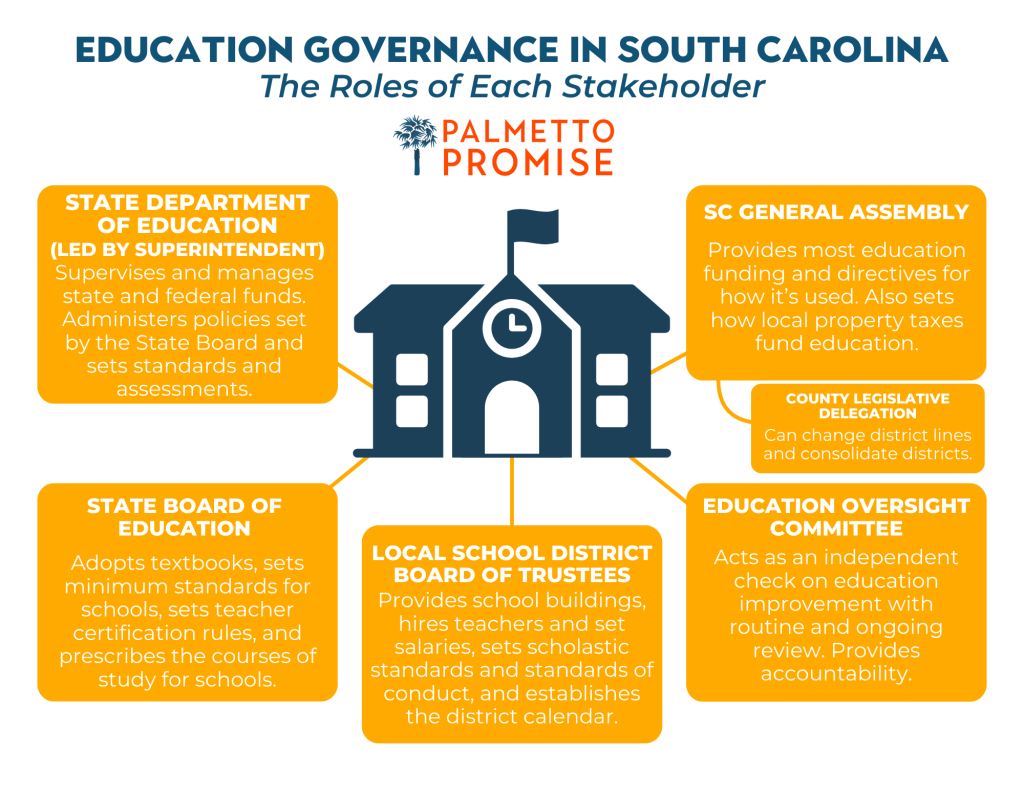A Quick Guide to Education Governance in South Carolina
South Carolina’s public education system is governed by a complex, and often overlapping, set of stakeholders, from the State Superintendent of Education to the State Board of Education, local school districts and their boards, district superintendents, and of course the General Assembly. Each of these parties has some role in how education is governed and administered in South Carolina. Quite frankly, there are a number of “cooks in the kitchen.” This can be overwhelming for citizens trying to determine the appropriate party to approach about a concern in the state education system.
With this guide, we hope to break down some of the mystery in the state’s education system and clarify how each stakeholder is involved in and responsible for public education in the Palmetto State.
In our 2017 report Stronger Together: Expanding Opportunity Through School District Consolidation, Dr. Oran Smith explained it like this: “The breakdown of responsibilities in local vs. state is generally that the state (State Department of Education, State Superintendent of Education, and General Assembly) provide funding and set standards. Local districts provide funding, build buildings, and hire teachers.”
Let’s break it down even further (with guidance from Dr. Holley Ulbrich’s paper “School District Organization and Governance in South Carolina”):
- [LOCAL SCHOOL DISTRICT] BOARDS OF TRUSTEES provide school buildings (including bonding for capital projects), employ teachers and set their salaries, set scholastic standards and standards of conduct, and establish the calendar.
- SUPERINTENDENTS, PRINCIPALS, AND OTHER DISTRICT ADMINISTRATORS carry out the policies set by the school board.
- The STATE DEPARTMENT OF EDUCATION, led by an elected SUPERINTENDENT OF EDUCATION, has both academic and fiscal responsibilities. The Department is responsible for administering the policies set by the State Board of Education. The Superintendent of Education administers the department and has general supervision and management of all public school funds provided by the state and federal government. The Department is charged with developing and releasing school and district report cards.
- STATE BOARD OF EDUCATION is responsible for establishing minimum standards for schools, prescribing and enforcing rules for certifying teachers, prescribing the courses of study for public schools, setting curriculum standards, and adopting textbooks and other instructional materials to be used in public schools. The board’s 17 members are elected by the legislature by judicial circuit, with one member at large appointed by the governor.
- The GENERAL ASSEMBLY provides a significant share of the funding and a fair amount of direction about how it may be used. The General Assembly also sets the parameters for the use of the property tax (the primary local funding source for schools).
- The LEGISLATIVE DELEGATION of each county has the power to change school district lines, change governance, consolidate districts, and in some districts appoint school board members.
- The EDUCATION OVERSIGHT COMMITTEE, which is unique to South Carolina, is composed of 18 members appointed by the General Assembly and the Governor. It provides regular, routine, and ongoing review of the state’s education improvement process. It provides accountability for public schools independent of the Department of Education. The EOC is also charged with approving academic content standards and assessments [testing], and establishing the state’s educational accountability system. The legislature has also tasked EOC with special projects from time to time outside of these responsibilities.
As you can see, each stakeholder has distinct responsibilities and its own part to play in administering South Carolina’s public education system.
For a visual depiction of education governance in South Carolina, see the graphic below:







